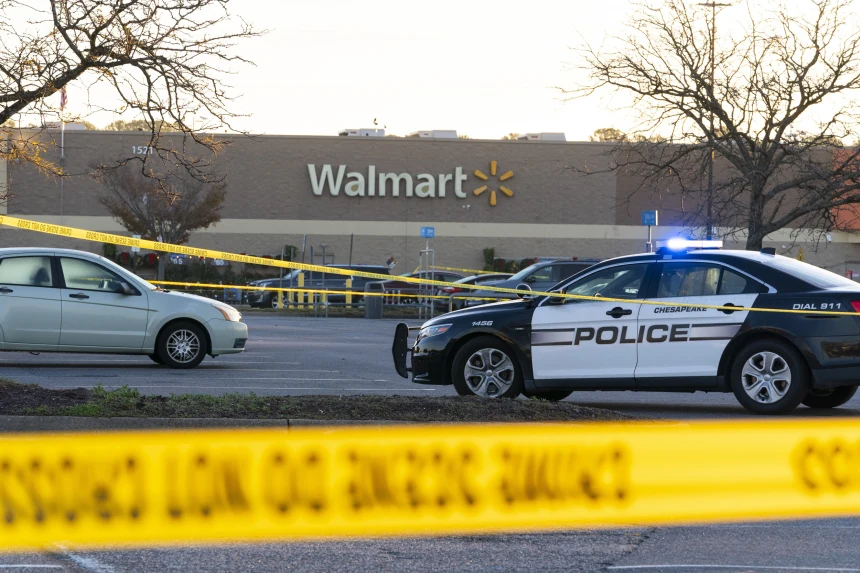
From reports this morning a disgruntled employee at the Walmart in Chesapeake Virginia open fired on his coworkers last night, killing 6 before killing himself. Unlike the Club Q shooting, the details coming out of this one appear to be tragically straight forward. An employee of the company felt wronged and chose violence as his method of retribution rather than quitting.
‘Disgruntled Employee’ won’t make as many headlines for as long as ‘MAGA Republican lawmaker’s Non-Binary Grandson attacks LGBTQ Club’ and the fact the employee apparently used the three times as common, and therefore more boring, handgun will also result in a quickly fading national interest beyond what can be leveraged for more gun control.
Nothing will be widely delved into about the employee’s alleged grievances, nothing will emerge on to what extent they were valid or exaggerated. Nobody will acknowledge that the media frenzy around events like Club Q, and now Walmart, will remind people, including those who it is dangerous to remind, that violence is a very attention grabbing option and that choosing it grants infamy. Infamy is enough for those dangerous few.
But what we’re seeing here is a dangerous inversion of the threat matrix. Being shot on any given day, especially in a mass shooting is an unlikely event. But it is a highly dangerous one, more so than tripping and twisting your ankle walking around your pet. The pet is a much more present hazard with a low probability of death, but they represent a substantial amount of the trip injuries that ERs see.
What I am getting at is the threat matrix, also known more broadly as risk assessment. While risk assessment can be used for all physical, social, and financial risks, a threat assessment is more focused on actual physical threats to you or your entity.
What is the risk a car crashes through the front of the store? What are the odds it is accidental vs deliberate? What are the odds someone shoots at you at work? What is the breakdown on the odds that the shooter is an employee, a known customer, or a random? These are all threat matrix type questions and anyone who has worked in business and professional safety for awhile will acknowledge that the people you know, employees and customers, are the higher threat when it comes to violence in the workplace. But that said, the overwhelming majority of your efforts will be spent preventing accidents and not assaults. That is how the threat matrix breaks down.
The biggest enemy of the publicly accessible space is the preventable injury, not a crazy customer or an angry employee.
Appropriate Appreciation of the Threat
The media is going to continue to make Colorado the scarier event, propping up their pet theory for why a prominent locale that supports a media relevant and controversial current hot button like drag was attacked. This puts the weight of the ‘next’ attack seem like it will be more LGBTQ clubs, and there is an appreciable threat there from the attention, the attitudes, and the current interest from various extreme elements.
But for Pulse and Club Q, how many workplace violence incidents do we have? How many disgruntled employees who resorted to homicide, maybe not to a mass shooting level? At the mass shooting level I can think of about a half a dozen, probably more given time to go through a list.
The risk of the Walmart type event is much greater than Club Q, and just as dangerous.
That said, the risk of either event is both low and yet appreciable. The risk of deliberate violence should never be downplayed, which is what CNN seems to mistake here,
Places traditionally seen as safe are far from it, we just do not pay attention. They are safe in scale, they are reasonably safe, they certainly aren’t at the risk level of a drug house about to be raided by the police or the streets of Iran filled with protestors. But they are not and never have been ‘safe’ in the objective sense, only in the relative. It can only ever be in the relative sense, true objective safety where nothing bad can occur is impossible.
Yet we still parrot the line and pretend that it is, because it is inconvenient to all involved to worry about the reality that it isn’t.
Should you be concerned about being shot today? Yes. But with very likely the same risk you had yesterday and tomorrow, so take prudent steps. You should also worry about tripping over your pet with very likely the same risk window. That is how risk works.



